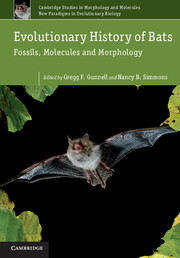Book contents
- Frontmatter
- Contents
- Contributors
- Preface
- 1 Phylogenies, fossils and functional genes: the evolution of echolocation in bats
- 2 Systematics and paleobiogeography of early bats
- 3 Shoulder joint and inner ear of Tachypteron franzeni, an emballonurid bat from the Middle Eocene of Messel
- 4 Evolutionary history of the Neotropical Chiroptera: the fossil record
- 5 New basal noctilionoid bats (Mammalia: Chiroptera) from the Oligocene of subtropical North America
- 6 Necromantis Weithofer, 1887, large carnivorous Middle and Late Eocene bats from the French Quercy Phosphorites: new data and unresolved relationships
- 7 African Vespertilionoidea (Chiroptera) and the antiquity of Myotinae
- 8 Evolutionary and ecological correlates of population genetic structure in bats
- 9 A bird? A plane? No, it's a bat: an introduction to the biomechanics of bat flight
- 10 Toward an integrative theory on the origin of bat flight
- 11 Molecular time scale of diversification of feeding strategy and morphology in New World Leaf-Nosed Bats (Phyllostomidae): a phylogenetic perspective
- 12 Why tribosphenic? On variation and constraint in developmental dynamics of chiropteran molars*
- 13 Necromantodonty, the primitive condition of lower molars among bats
- 14 Echolocation, evo-devo and the evolution of bat crania
- 15 Vertebral fusion in bats: phylogenetic patterns and functional relationships
- 16 Early evolution of body size in bats
- Index
- Plate section
- References
7 - African Vespertilionoidea (Chiroptera) and the antiquity of Myotinae
Published online by Cambridge University Press: 05 June 2012
- Frontmatter
- Contents
- Contributors
- Preface
- 1 Phylogenies, fossils and functional genes: the evolution of echolocation in bats
- 2 Systematics and paleobiogeography of early bats
- 3 Shoulder joint and inner ear of Tachypteron franzeni, an emballonurid bat from the Middle Eocene of Messel
- 4 Evolutionary history of the Neotropical Chiroptera: the fossil record
- 5 New basal noctilionoid bats (Mammalia: Chiroptera) from the Oligocene of subtropical North America
- 6 Necromantis Weithofer, 1887, large carnivorous Middle and Late Eocene bats from the French Quercy Phosphorites: new data and unresolved relationships
- 7 African Vespertilionoidea (Chiroptera) and the antiquity of Myotinae
- 8 Evolutionary and ecological correlates of population genetic structure in bats
- 9 A bird? A plane? No, it's a bat: an introduction to the biomechanics of bat flight
- 10 Toward an integrative theory on the origin of bat flight
- 11 Molecular time scale of diversification of feeding strategy and morphology in New World Leaf-Nosed Bats (Phyllostomidae): a phylogenetic perspective
- 12 Why tribosphenic? On variation and constraint in developmental dynamics of chiropteran molars*
- 13 Necromantodonty, the primitive condition of lower molars among bats
- 14 Echolocation, evo-devo and the evolution of bat crania
- 15 Vertebral fusion in bats: phylogenetic patterns and functional relationships
- 16 Early evolution of body size in bats
- Index
- Plate section
- References
Summary
Introduction
Vesper and evening bats (Family Verspertilionidae) are a diverse group (about 350 living species) that has a nearly global distribution (being absent only in polar regions, on some oceanic islands and in harsher desert climates). Vespertilionids often have been included with molossids, mystacinids, myzopodids, thyropterids, furipterids and natalids in the superfamily Vespertilionoidea (Koopman, 1994), but many other variations of the superfamily exist (e.g., Simmons, 1998; Jones et al., 2002; Hoofer and Van Den Bussche, 2003; Hoofer et al., 2003; Horáček et al., 2006; Miller-Butterworth et al., 2007). Our prime focus in this chapter is on two subfamilies of the Vespertilionidae, Vespertilioninae and Myotinae, as defined by Simmons (2005).
Osteologically, the basic dichotomy between myotines and vespertilionines can be typified by differing patterns of dental morphology. All myotines share myotodont lower molar morphology, in which the postcristid extends to the entoconid and isolates the hypoconulid (as opposed to nyctalodonty where the postcristid extends to the hypoconulid and does not reach the entoconid). Myotines also share the presence of three premolars, with the middle premolar being reduced. Some vespertilionines have myotodont lower molars, but only a few exhibit both myotodonty and the retention of three premolars (e.g., Plecotus and Idionycteris). No vespertilionines have the middle premolar reduced. Recent phylogenetic analyses suggest that all vespertilionines are far removed from myotines (e.g., Hoofer and Van Den Bussche, 2003), implying that any shared morphological similarities are likely to be convergences.
- Type
- Chapter
- Information
- Evolutionary History of BatsFossils, Molecules and Morphology, pp. 252 - 266Publisher: Cambridge University PressPrint publication year: 2012
References
- 3
- Cited by



